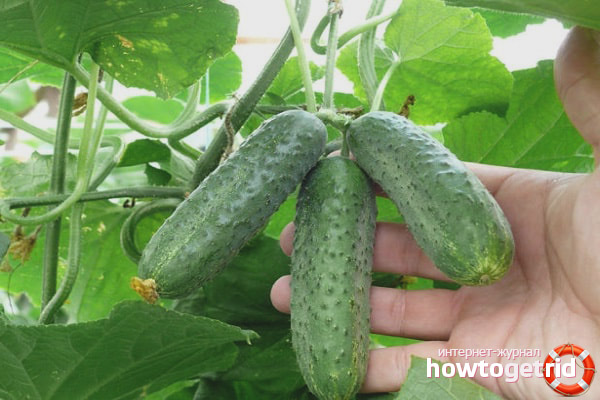The content of the article
Not a single summer cottage is complete without cucumbers. This vegetable crop has earned the recognition and love of many gardeners. But the choice of a particular cucumber variety depends on its main characteristics and personal individual preferences.
The cucumber variety Hit of the season F1 is suitable for universal methods of cultivation, and thanks to this, the choice of many summer residents stops on it. It grows well in open ground, in greenhouses and even on the windowsill.
Grade description
The plant has the following characteristics:
- Refers to a hybrid cultivar of parthenocarpic species of the female flowering type, which means its ability to form fruits without pollination.
- Gives a high yield.
- It differs in early maturity, matures within 40 days.
- Has a long, until the autumn frosts, fruiting period.
- With a bunch arrangement of ovaries: in one node up to six ovaries are formed at once.
- It has stable fruit formation, which is ensured by alternating with a difference of one day of opening flowers in a bunch and the obligatory formation of ovaries due to this, regardless of weather conditions.
- The simultaneous growth of several cucumbers from one leaf sinus at once, which prevents the possibility of overripening due to lack of nutrients from one source.
- On the plant, up to 15 greens mature at the same time, which makes it possible to simultaneously remove a good crop.
- Resistant to many cucumber diseases and pests.
- Unpretentious in care, bears fruit even in adverse conditions.
External characteristics of the fetus:
- gherkin type;
- elongated elongated shape;
- bright green skin color;
- in length reaches up to 12.0 cm;
- the weight of one cucumber is up to 110 g .;
- has white spines evenly distributed along the entire length of the fetus.
It tastes like cucumbers without bitterness. Crispy, white flesh inside. Easy to tolerate transportation and have a long shelf life. The variety is suitable for fresh consumption and for preservation for the winter. With proper care from 1 m2, you can get up to 12.0 kg of gherkins.
Growing technology
A culture can be grown in one of two ways:
- Seedlings, it is planted 2-3 weeks before transplantation.
- By planting directly in the ground at a permanent place of cultivation.
The specific choice of method of cultivation depends on the habit and convenience of the landowner.
Seedlings are planted in containers filled with earth to a depth of 3.0 cm. You can prepare good favorable soil for seedlings yourself. To do this, it is necessary to combine in percentage terms one part of sand and sod land with two parts of humus.
Given the vulnerability of the root system of cucumbers, to minimize the impact on it, it is recommended to use peat pots as a capacity for seedlings. An additional advantage of using will be their ability to decompose after planting in the ground. When decomposed, they give basal fertilizer to transplanted seedlings and have a beneficial effect on their growth.
Planting in the soil is carried out in pre-prepared wells, in which humus and wood ash are added. At the end of planting, the plants are tightened with a film. In each bed per 1 m2 up to four plants are located, in the greenhouse - up to two.
The plant loves sunlight, but also bears fruit well in a darkened place. The number of ovaries formed in bundles depends on the level of illumination of the place of growth. With more sunlight, buds appear more often.Cucumber does not like drafts, preferably growing it in a place protected from gusts of wind.
Tips

Tips of gardeners with experience in growing cucumbers of this type:
- To ensure the safety of the first seedlings of the plant, they should be closed with plastic bottles.
- A good crop is obtained when filling the hole for planting with ash and compost.
- In the fight against the spider mite that appears on the fruits in early summer, Fitoverm helps to cope with the first treatment.
- As top dressing, you can use mowed grass, flooded with water and aged for ten days.
- Cucumbers should be harvested every two days, as they grow in clusters and take away nutrients from other, not yet ripened fruits.
Cultural Courts
Planted vegetables require care. The main procedures that must be performed to care for this variety of cucumbers do not differ from those that are used to take care of other types of cucumbers, and are as follows:
- Watering with warm water heated by sunshine in barrels. It is better to water in the evening, at sunset.
- Loosening, which provides oxygen to the root system. So the plant will retain the moisture received longer.
- Weed weeding.
- Top dressing. It is better to use organic and complex fertilizers. The recommended feeding period is once a week.
- Mulching. Coating the surface layer of soil with materials of artificial or natural origin. This relieves the plant of pests, preserves the natural moisture of the soil, protects from wind, reduces the number of weeds, prevents the appearance of crust on the soil and facilitates the process of watering.
- Treatment. It is carried out in order to prevent infection by diseases from which the plant does not develop immunity.
Disease resistance
One of the main criteria for choosing one or another variety of cucumber is the immunity of the plant, its resistance to various diseases. The less it is susceptible to disease, the easier it is to take care of it, and the greater the chance of a high yield.
The hit of the F1 season is not affected by powdery mildew, olive spotting, and is immune to the cucumber mosaic virus. Resists diseases of downy mildew, root rot.
Video: Hit cucumbers of season F1










Submit